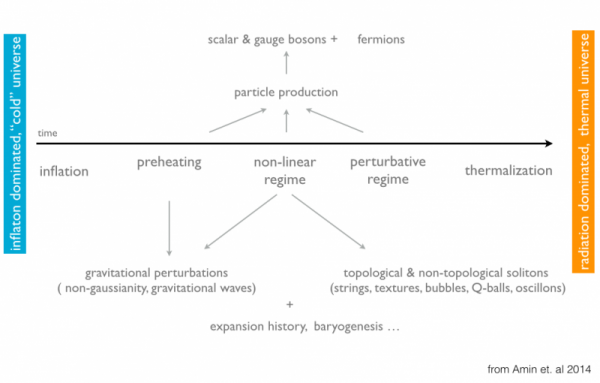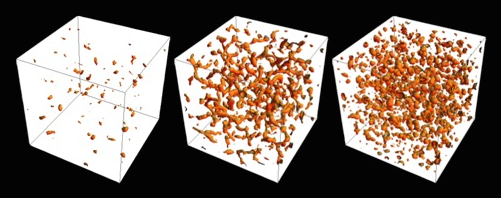Reheating after inflation

Figure: Schematic view of reheating after inflation.
Inflation, a period of accelerated expansion very early in the history of our Universe set up the initial conditions necessary for formation of galaxies. Such initial conditions are remarkably consistent with the anisotropies in the cosmic microwave background (CMB) measured by Planck. However, inflation left the Universe cold and empty. How did inflation end? How did the Hot Big Bang begin? How did the Universe get “heated up” and populated with a thermal soup of particles (reheating)?
This period of reheating, potentially spanning an energy range from 1015 GeV (end of inflation) to 10-3 GeV (Big Bang Nucleosynthesis) presents a huge gap in our understanding of our Universe’s history. Reheating after inflation provides a link between the inflaton and the Standard model. Understanding the expansion history during this period is essential in connecting the observations of CMB anisotropies to the inflationary models that provide the initial conditions for these anisotropies. The rich dynamics during this period can produce relics such as high-frequency gravitational waves, defects, solitons, primordial blackholes, non-Gaussian perturbations in the CMB and primordial magnetic fields.
At KICC, we are trying to understand the complex dynamics at the end of inflation, the highly nonlinear dynamics of the energy transfer from the inflaton to Standard Model fields and potential observational consequences of this process. We are developing novel analytic techniques and carrying out detailed numerical simulations to describe quantitatively the rich dynamics at the end of inflation.

Figure: Inflaton fragmentation and soliton (oscillon) formation at the end of inflation. The surfaces are drawn at five times the background energy density. The box is a comparable to the Hubble horizon at the end of inflation (from Lozanov & Amin 2014).
For theoretically well-motivated and observationally consistent models of inflation (“flattened potentials”), the end of inflation might result in the formation of pseudo-solitons called oscillons that may dominate the energy density of the universe for some time. We are investigating the conditions for such soliton formation and domination, as well as the impact of this soliton formation on the path to the thermal, radiation-dominated era.
The complex dynamics at the end of inflation can have an impact on other important observables such as the matter/anti-matter asymmetry, albeit in a very model dependent way. For example, we have shown that in models where the matter/antimatter asymmetry is generated by the inflaton, the actual value of the matter/antimatter asymmetry can be affected by the nonlinear fragmentation of the inflaton.
We are currently developing numerical and analytical techniques to understand the dynamics of energy transfer from the inflaton to gauge fields (Abelian and non-Abelian). At KICC, we are also investigating novel connections of the nonlinear dynamics in the early Universe to similar phenomenon in condensed-matter systems.


